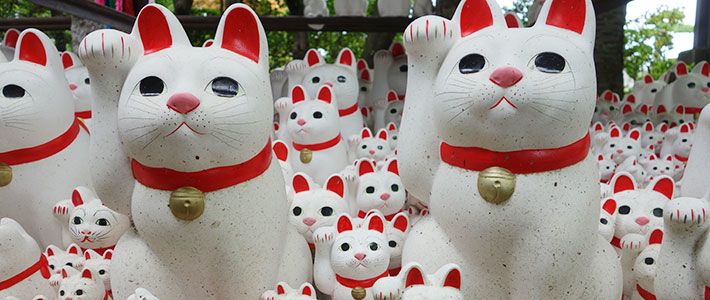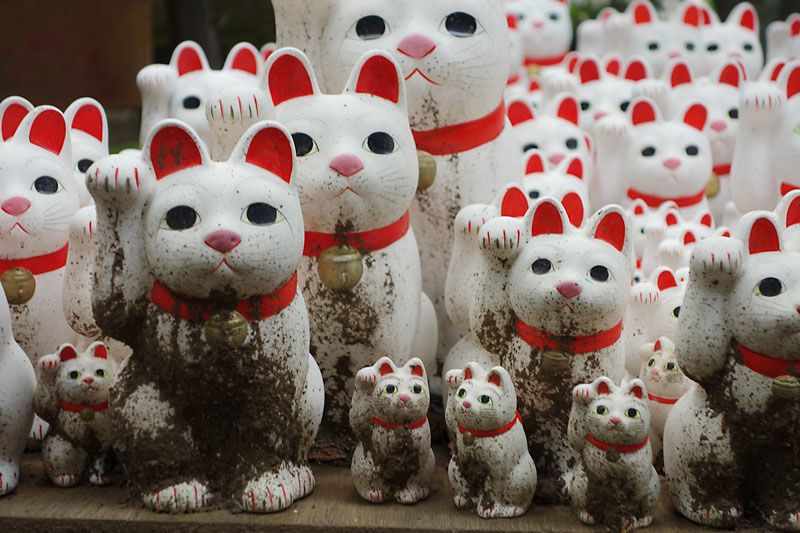
Fortune Beckons: Japan’s Lucky Cat Figurines
Society Culture- English
- 日本語
- 简体字
- 繁體字
- Français
- Español
- العربية
- Русский
One cat with its paw up beckoning you forward can be cute. When you’re up against a whole army, though, it’s disconcerting.
These cats, known as manekineko, are said to bring good fortune and are a common sight in Japan at the entrance to shops and restaurants. They come in many different varieties, which is one reason why it’s unsettling to find a uniform group differentiated only by size. It’s a bit like facing a crowd at a sports event or political rally.
Murky Origins
The feline throng can be found in Gōtokuji, a temple in Setagaya, Tokyo. According to legend, a seventeenth-century lord of the Hikone domain (today part of Shiga Prefecture) was passing by when a cat sprang up and beckoned him into the temple grounds. He was glad he accepted its invitation, as a sudden rainstorm pelted down and he avoided a soaking. In gratitude, he made major donations and designated his place of shelter as his family temple.
An area of the temple was set aside for the cats as part of the worship of the Bodhisattva Kannon, the goddess (sometimes god) of mercy. When their prayers were granted, people made offerings of manekineko in thanks. Thus the collection began. There may have been a bit more of a mixture of styles in the early days, but now the only ones on display are the temple-approved white cats.
Some say this was where beckoning cats began, but there are plenty of other theories. Imado Shrine, also in Tokyo, makes one of the more famous claims with its story of an old woman who had to let her cat go because she was too poor to feed it. The cat came to her in a dream and suggested she start making ceramic figurines in its image—she did so, and the manekineko was born.
While it’s difficult to choose between these and other murky origin stories, we can at least say that the cat at Gōtokuji was the inspiration for one of the first superstar city mascots. Hikonyan, a cat samurai created in 2007, takes his name from his home city of Hikone in Shiga Prefecture and nyan, the Japanese for “meow.” The decision to commemorate the rain escape shows that a strong connection clearly remains between the Tokyo temple and the western Japanese city.
Many, Many Manekineko
The manekineko beckon in the Japanese way, with the palm facing downward—to someone from an English-speaking country they might look like they’re waving. It’s commonly said that a cat with its right paw raised brings money, while a leftie invite draws in customers. Why not go all the way and make cats with both paws raised? Some do, but it’s generally considered cheating—and it looks too much like a banzai cheer anyway.
Different colors are also said to have different meanings. While the most common white cats are fairly generic, black cats are said to ward off evil spirits, red cats to drive away illness, and gold cats to bring the cash rolling in. Beyond these more traditional colors, it partly depends on who’s marketing the cats, but the concept of pink figurines for those who want to be lucky in love seems to have established itself.
Manekineko are now increasingly seen outside Japan, such as in Taiwan and particularly in various Chinatowns around the world, where they are commonly known as “lucky cats.” In fact, the Chinatown connection has become so strong many are mistaken into thinking they were originally Chinese. (I remember being surprised to see them popping up in London’s Chinatown in an episode of Sherlock.)
Under the Weather
One thing the cats at Gōtokuji don’t have that many of their fellow feline lucky charms do is a koban, an oval gold coin from the Edo period (1603–1868), clutched in the lowered paw. Again, the reason is not wholly clear, but it’s probably considered inappropriate to the temple setting. Incidentally, the popular proverb neko ni koban (meaning “a gold coin to a cat,” or idiomatically, “pearls before swine”) flatly contradicts the idea that cats know anything about money!
What they lack in financial resources they certainly make up for in numbers, at least at this temple. There must be about a thousand of them crammed into the small area. It makes me wonder if they’ll ever run out of space or if the older ones get replaced. Truth be told, some of the cats gathered on one side look a bit weather-beaten. It’s a little hard on the Gōtokuji manekineko who made their name by saving a samurai from a drenching.


